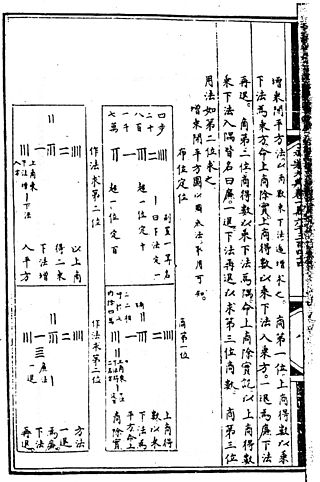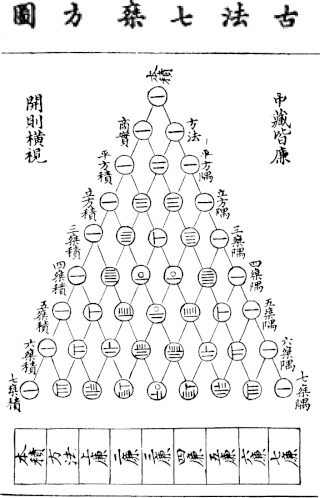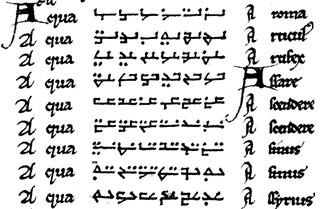Related Research Articles
Chinese numerals are words and characters used to denote numbers in Chinese.

The Maya numeral system was the system to represent numbers and calendar dates in the Maya civilization. It was a vigesimal (base-20) positional numeral system. The numerals are made up of three symbols: zero, one and five. For example, thirteen is written as three dots in a horizontal row above two horizontal bars; sometimes it is also written as three vertical dots to the left of two vertical bars. With these three symbols, each of the twenty vigesimal digits could be written.
Big-5 or Big5 is a Chinese character encoding method used in Taiwan, Hong Kong, and Macau for traditional Chinese characters.
A numerical digit is a single symbol used alone or in combinations, to represent numbers in a positional numeral system. The name "digit" comes from the fact that the ten digits of the hands correspond to the ten symbols of the common base 10 numeral system, i.e. the decimal digits.
GB/T 2312-1980 is a key official character set of the People's Republic of China, used for Simplified Chinese characters. GB2312 is the registered internet name for EUC-CN, which is its usual encoded form. GB refers to the Guobiao standards (国家标准), whereas the T suffix denotes a non-mandatory standard.

Iteration marks are characters or punctuation marks that represent a duplicated character or word.
The Suzhou numerals, also known as Sūzhōu mǎzi (蘇州碼子), is a numeral system used in China before the introduction of Arabic numerals. The Suzhou numerals are also known as huāmǎ (花碼), cǎomǎ (草碼), jīngzǐmǎ (菁仔碼), fānzǐmǎ (番仔碼) and shāngmǎ (商碼).

The Hindu–Arabic numeral system or Indo-Arabic numeral system is a positional decimal numeral system, and is the most common system for the symbolic representation of numbers in the world.
In Unicode and the UCS, a compatibility character is a character that is encoded solely to maintain round-trip convertibility with other, often older, standards. As the Unicode Glossary says:
A character that would not have been encoded except for compatibility and round-trip convertibility with other standards
A numeral is a character that denotes a number. The decimal number digits 0–9 are used widely in various writing systems throughout the world, however the graphemes representing the decimal digits differ widely. Therefore Unicode includes 22 different sets of graphemes for the decimal digits, and also various decimal points, thousands separators, negative signs, etc. Unicode also includes several non-decimal numerals such as Aegean numerals, Roman numerals, counting rod numerals, Mayan numerals, Cuneiform numerals and ancient Greek numerals. There is also a large number of typographical variations of the Western Arabic numerals provided for specialized mathematical use and for compatibility with earlier character sets, such as ² or ②, and composite characters such as ½.
The text Tài Xuán Jīng is a guide for divination composed by the Confucian writer Yang Xiong. The first draft of this work was completed in 2 BCE. During the Jin dynasty, an otherwise unknown person named Fan Wang salvaged the text and wrote a commentary on it, from which our text survives today.

Rod calculus or rod calculation was the mechanical method of algorithmic computation with counting rods in China from the Warring States to Ming dynasty before the counting rods were increasingly replaced by the more convenient and faster abacus. Rod calculus played a key role in the development of Chinese mathematics to its height in Song Dynasty and Yuan Dynasty, culminating in the invention of polynomial equations of up to four unknowns in the work of Zhu Shijie.
Bopomofo, or Mandarin Phonetic Symbols, also named Zhuyin, is a Chinese transliteration and writing system for Mandarin Chinese and other related languages and dialects. More commonly used in Taiwanese Mandarin, it may also be used to transcribe other varieties of Chinese, particularly other varieties of Mandarin Chinese dialects, as well as Taiwanese Hokkien. Consisting of 37 characters and five tone marks, it transcribes all possible sounds in Mandarin.

Counting rods are small bars, typically 3–14 cm long, that were used by mathematicians for calculation in ancient East Asia. They are placed either horizontally or vertically to represent any integer or rational number.
The Unicode Standard assigns various properties to each Unicode character and code point.
Mongolian is a Unicode block containing characters for dialects of Mongolian, Manchu, and Sibe languages. It is traditionally written in vertical lines Top-Down, right across the page, although the Unicode code charts cite the characters rotated to horizontal orientation as this is the orientation of glyphs in a font that supports layout in vertical orientation.
Coptic Epact Numbers is a Unicode block containing old Coptic number forms.
Early Dynastic Cuneiform is the name of a Unicode block of the Supplementary Multilingual Plane (SMP), at U+12480–U+1254F, introduced in version 8.0. It is a supplement to the earlier encoding of the cuneiform script in the two blocks U+12000–U+123FF "Cuneiform" and U+12400–U+1247F "Cuneiform Numbers and Punctuation".

Tally marks, also called hash marks, are a form of numeral used for counting. They can be thought of as a unary numeral system.

The medieval Cistercian numerals, or "ciphers" in nineteenth-century parlance, were developed by the Cistercian monastic order in the early thirteenth century at about the time that Arabic numerals were introduced to northwestern Europe. They are more compact than Arabic or Roman numerals, with a single glyph able to indicate any integer from 1 to 9,999.
References
- ↑ "Unicode character database". The Unicode Standard. Retrieved 2023-07-26.
- ↑ "Enumerated Versions of The Unicode Standard". The Unicode Standard. Retrieved 2023-07-26.
- ↑ The Unicode Standard, Version 15.0 – Electronic edition (PDF), Unicode, Inc., 2022, pp. 869–870